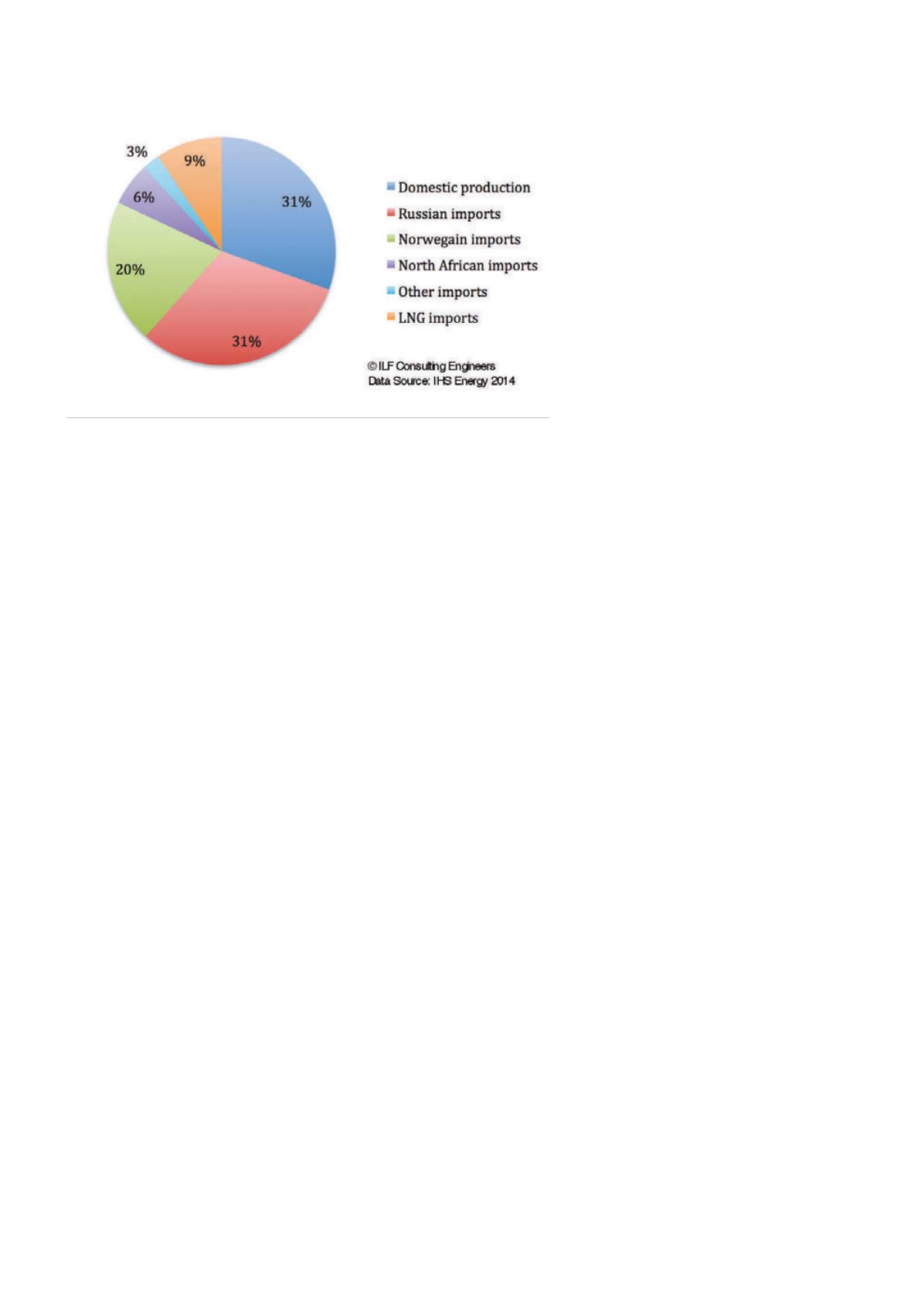
renewable energies, gas demand had dropped from almost
522 billion m
3
in 2010 to 461 billion m
3
in 2013.
3
At the same
time, according to the International Energy Agency (IEA)
Europe’s gas production in 2020 is expected to be 25%
below its 2010 level.
4
As a consequence, EU gas import
requirements are to increase by almost one-third between
2014 and 2020.
5
In order to meet EU demand, gas is currently imported
through three large corridors: the eastern corridor from
Russia, the northern corridor from Norway, and the
Mediterranean corridor from Libya and Algeria. In addition,
LNG is imported, with Qatar and Algeria being Europe’s
leading LNG providers. Imports from the US have also
been growing since the shale gas boom.
6
LNG supplies
are expected to further grow over the next five years and
Europe is set to offer an important outlet.
7
The Southern Gas Corridor –
diversification of gas supplies to European
markets
A fourth gas entry route, the Southern Gas Corridor,
carrying Caspian gas and potentially gas from the Middle
East and Central Asia, has been recognised by the EC for
its strategic importance in terms of EU’s energy security.
8
This megaproject, which requires approximately US$45
billion of investment,
9
involves the construction of three
major pipeline sections, in total stretching across 3500
km to provide an export route to Europe for Azerbaijan’s
offshore Shah Deniz 2 gas field in the Caspian Sea: the
South Caucasus Pipeline (SCP), the Trans-Anatolian Gas
Pipeline (TANAP) and Trans-Adriatic Pipeline (TAP). SCP is
already in place, but requires capacity extensions, while
TANAP and TAP are yet to be constructed.
As the main source of supply to the Southern Gas
Corridor, BP’s Shah Deniz 2 gas field will deliver 16 billion
m
3
/yr of gas through the Sangachal Terminal in Baku,
Azerbaijan into the expanded South Caucasus Pipeline
(SCPX), which runs via Tbilisi to Erzurum in Turkey along
the route of the Baku-Tbilisi-Ceyhan (BTC)
crude oil pipeline.
Since 2006, the SCP (692 km, 42 in.) has
been jointly operated by BP and Statoil to
supply markets in Turkey and Georgia. The
current SCPX project involves the looping
of the SCP in Azerbaijan and partially in
Georgia, as well as the construction of
two new compressor stations in Georgia
to increase the overall capacity to
23 billion m
3
/yr.
10
TANAP is now being constructed. It is one
of the longest pipeline projects in the world
at over 1841 km in length, 56 in. diameter
and 16 billion m
3
/yr capacity, with a planned
expansion to 31 billion m
3
/yr. The ground-
breaking ceremony for TANAP – the longest
and most expensive element of the Southern Gas Corridor
– in the city of Kars north-east of Turkey in March this
year, marked a major milestone in the Southern Gas
Corridor’s development.
The impressive, US$10 billion pipeline,
11
which includes
a Marmara sea crossing section as well as multiple
compressor stations, will cross the whole country from
east to west, traversing 20 provinces, 67 districts and nearly
600 villages and mountains up to 2800 m above sea level.
TANAP is being developed by a consortium consisting of
SOCAR, BOTAS, and BP. ILF Consulting Engineers, a German
engineering consultant with 35 years of project history in
Turkey was awarded the Project Management and Owner’s
Engineering (PMOE) contract in the initial phases of the
project and now continues to support the integrated
management team of TANAP, while an EPCM contract was
awarded to WorleyParsons Resources and Energy, London.
Turkey will receive 6 billion m
3
/yr from TANAP.
Starting at the border to Greece, TAP will transport the
remaining 10 billion m
3
/yr, which is destined for Europe
across 870 km via Albania and the Adriatic Sea to Italy.
According to the Front-End Engineering Design (FEED) for
the pipeline, which was completed by ILF in 2012, phase
one of TAP will have a capacity of 10 billion m
3
/ yr.
However, the pipeline system is designed so that its
capacity can be doubled to 20 billion m
3
/yr in a potential
phase two.
By the end of 2015, major procurement contracts will
be awarded. With the Italian government having signed its
final approval, the construction of the pipeline is expected
to start in 2016. First gas is expected to be delivered in
2020.
12
TAP was preferred as the western extension by the
TANAP shareholders over the Nabucco West project,
which was designed to cross Bulgaria, Romania, and
Hungary and to finish in Austria. TAP joint venture’s
shareholders are BP (20%), SOCAR (20%), Statoil (20%),
Fluxys (19%), Enagás (16%) and Axpo (5%).
Figure 2.
EU gas supply in 2014.
26
World Pipelines
/
AUGUST 2015


